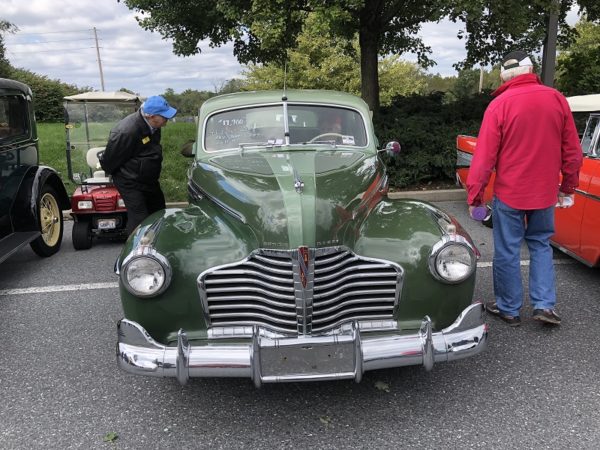
And so, finally, on our American Journey, we reached the Hershey Fall Meet – a magnificent mix of the most exotic and the most basic cars, with an eclectic mix of people of all sorts, all of them friendly and informative.
Don Pyle’s 1941 Buick Super
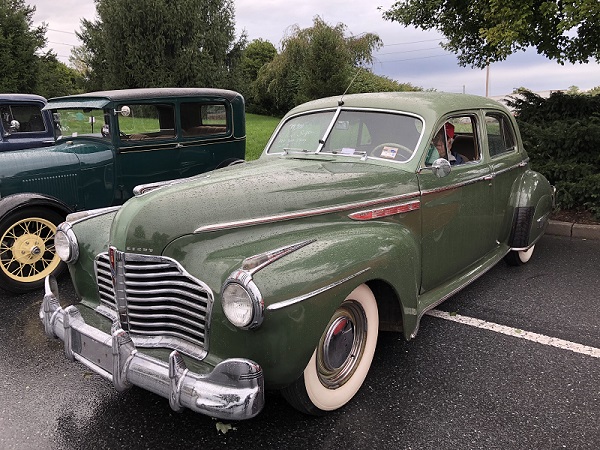
Hershey is, above all, about the people you meet – in particular on the ‘Car Corral’ – the long road that sweeps across the top of the fields, where vendors can display and try to sell their machines. One remarkable gentleman here was Don Pyle, who has been trading in classic American cars for very many years. He very kindly sent us a privately-published book about the cars he has sold, in return for which we promised to put his car at the top of our Hershey report. So we did – one picture from Wednesday when the weather was fair, and one from Thursday when it poured with rain!
1903 Stanley Model C
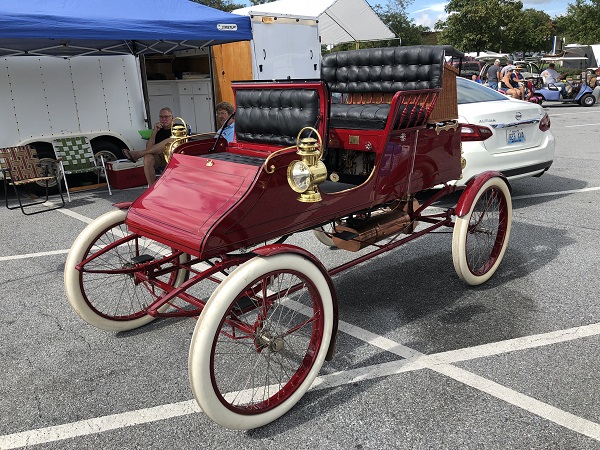
From the earliest years of Stanley production comes this lightweight, spindly Stanley Steamer, beautifully restored and ready to go. These early Stanleys have the boiler directly under the driver’s seat and above the copper-clad cylinders, valve gear and final drive. Later, the boiler was moved to the front of the vehicle to make the car look more similar to other cars of the period – and to make the car quieter for passengers.
1948 Chrysler Town & Country 2-door Convertible
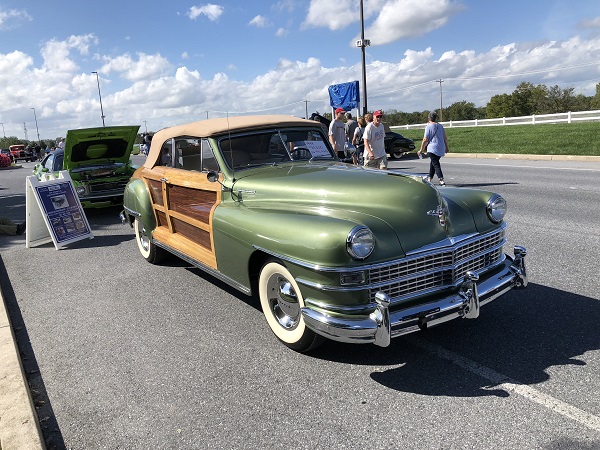
No trip to the USA is complete without seeing a ‘Woody’. These cars, made from 1940 onwards with a break during World War II typify the confidence of the American car industry and its prosperous customers.
1958 Packard Starlight Hardtop
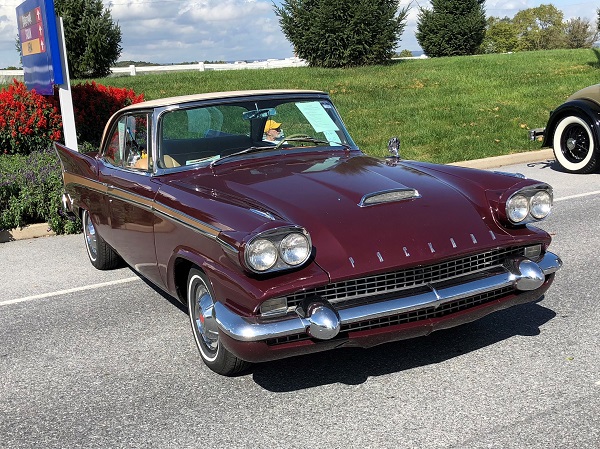
The 1957 and 1958 Packard cars were based on Studebaker models: restyled, rebadged, and given more luxurious interiors. After 1956, the Packard engine and transmission factory was leased to the Curtiss-Wright Corporation and the assembly plant in Detroit was sold, thus ending the production of true Packards. But the newly-merged Studebaker-Packard company hoped to keep the Packard name alive until a totally new model could be funded and developed. Sadly, this never came to pass, and this 1958 Packard Starlight is a rare car.
1912 Marion Model 33 Bobcat
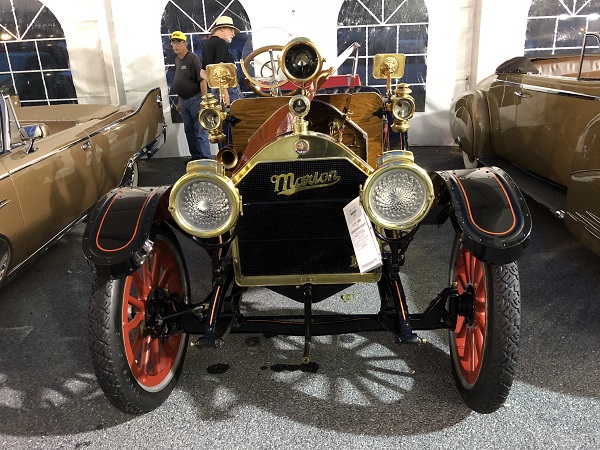
This is another rare survivor. Built in Indianapolis, the Marion was designed by Harry Stutz, who later went on to build the famous cars that bore his name. In 1905 he designed a car for the American Motor Car Company, and moved again in 1907 to become chief engineer and factory manager at Marion Motor Car Company – where he also became one of the company’s racing drivers.
Advertised as “The Car That Has Set Men to Thinking,” the Marion was a four-cylinder car of 16 to 45 hp, selling at $1,600 to $2,000, which at the time would buy the most expensive Buick. The Bobcat, of which this is a lovely example, was described by the late historian Beverly Rae Kimes as a “rakish machine.” It almost certainly influenced the design and sporting spirit of Harry Stutz’s own Bearcat.
Another view of the Bobcat, showing its “rakish” style.
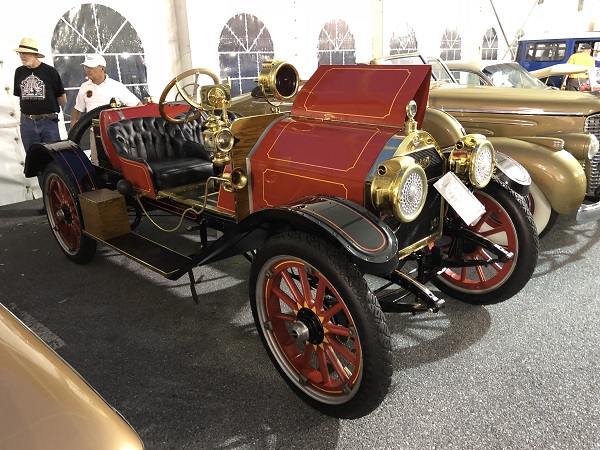
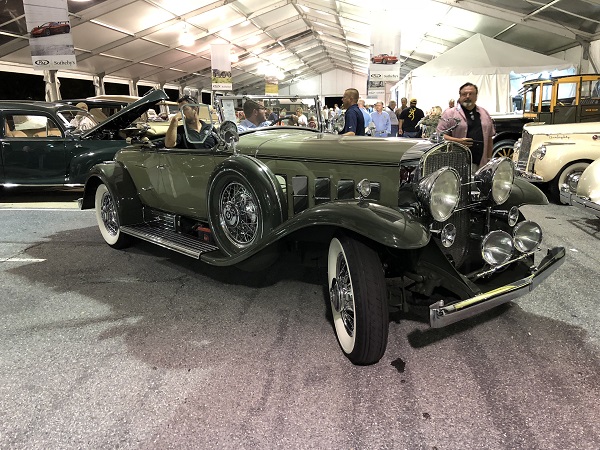
Seen manoeuvring at the pre-auction viewing of the RM-Sotheby’s auction, this Cadillac is here showing off its party trick: spotlights that turn with the front wheels, nearly 40 years before Citroën introduced turning lights on the DS model.
… and the other direction!
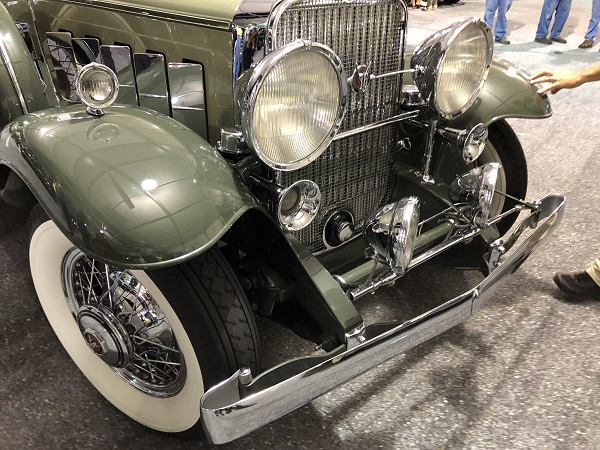
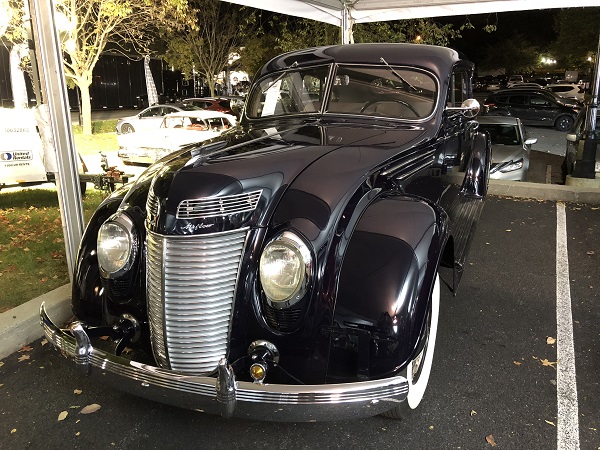
This Chrysler was of particular interest because it comes from the very last year of Airflow production and illustrates how Chrysler significantly toned down the futuristic streamlined appearance of the car after meeting considerable resistance from the buying public. This car is almost – but not quite – conventional in its styling.
1930 DuPont Model G Convertible
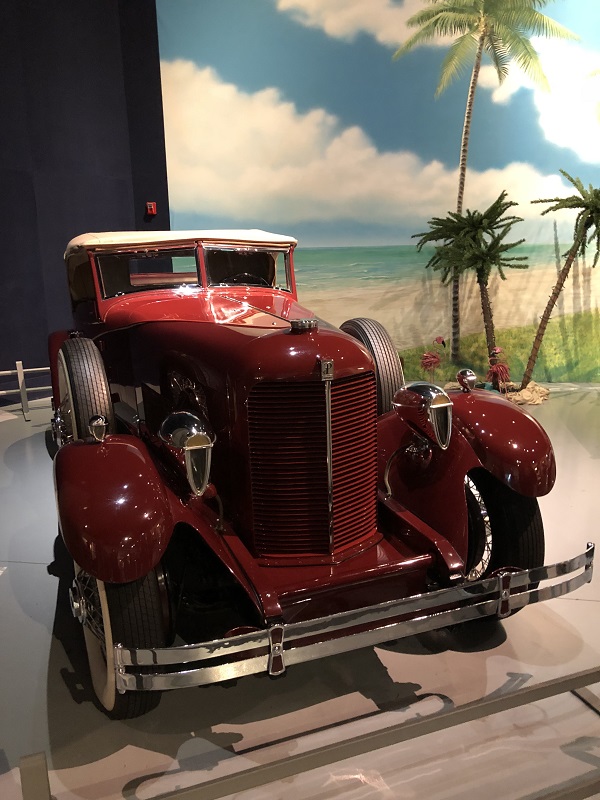
The Hershey Fall Meet has far more to offer than the cars and parts displayed in the many sections of the main event. On a rainy Thursday, we were able to find some shelter and much to amaze in the superb Antique Automobile Club of America (AACA) Museum. This DuPont is one of very few survivors of a very up-market machine made by the famous chemical company as a separate venture in Wilmington, Delaware. The Model G was introduced in 1928, with a 5.3-litre side-valve straight eight engine of 125 bhp. It was compared to such luxury cars as Packard, Cadillac and even Duesenberg, and was known for its quality and style. DuPont customers included Mary Pickford, Douglas Fairbanks, Will Rogers and Jack Dempsey.
As we can see in this picture, the Dupont was also one of a few makes that used the stylish, streamlined but rather ineffective Woodlite headlamps; Cord, Packard and Ruxton were others.
1946 Whizzer
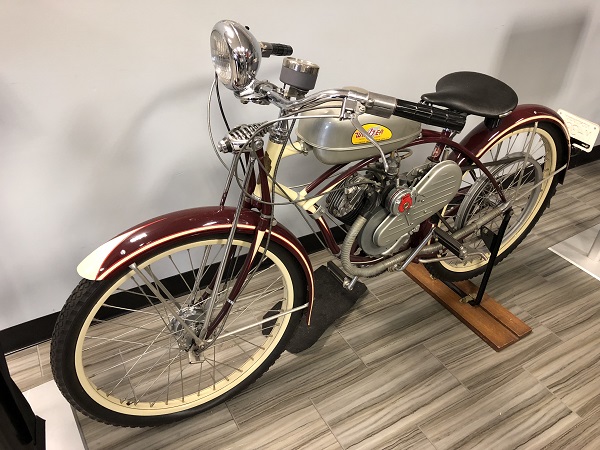
On the upper floor is a small collection of small motorbikes – and the most delightful of these was a 1946 Whizzer. For many youngsters eager to have their first means of transportation this was the thing to have. Originally, the 4-stroke 138cc 2.5 bhp engine was sold in kit form to be mounted on a buyer’s bicycle. The first owner of this example mounted it on a Dixie Flyer frame and then on this Schwinn frame. There was a group of enthusiastic bikers gathered around this bike, eager to explain how the Whizzer was their first foray into the world of biking. Top speed may only be 35 mph, but 125 mpg is possible.
Transport around Hershey – free of charge!

Hershey is enormous – and speedy travel between hotels, campsites, the museum and the many fields is made possible by the school buses during Hershey week. The Hershey Company pays for the provision and running of these school buses throughout the year, so in return the drivers volunteer for this one week. The tradition, however, is that they very politely ask for tips – here is one example, and enormous jar was generously filled by grateful passengers, especially on this one rainy day. The drivers were always friendly and extremely well informed: “don’t get on this one – the next one goes direct to the Red Field!”
1942 Crosley Convertible
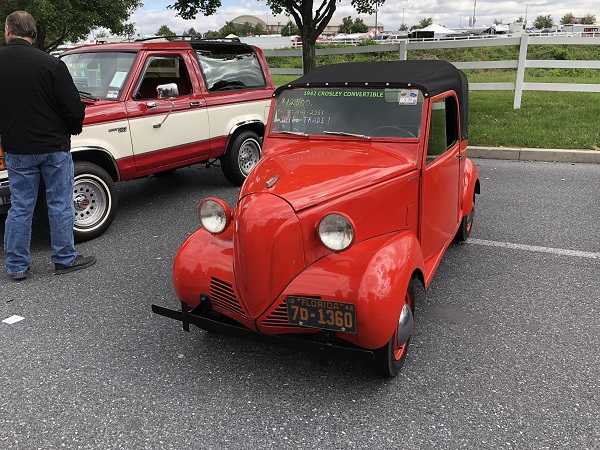
All American cars are enormous, aren’t they? No. This tiny Crosley looked somewhat forlorn, but is an important part of US motoring history. First launched in 1939, Crosley cars were two-door convertibles that weighed less than 1,000 pounds (454 kg). They were cheaper than the nearest competition, the American Austin Car Company’s American Bantam.
During World War II, petrol rationing and the car’s fuel efficiency made the Crosley an attractive means of transport for some. Crosley was the last car company to cease production of civilian vehicles in 1942, with 1,000 cars produced in that year and a total of over 5,700 made up to that point.
After turning to wartime production, Crosley resumed car manufacture in 1946 and the company survived until 1952.
1928 Minerva Model AK
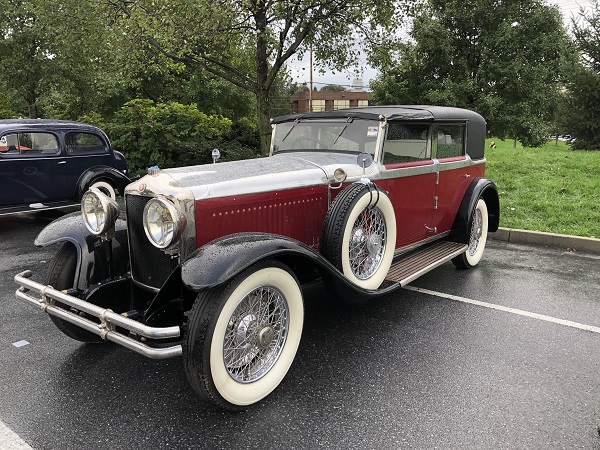
This magnificent monster stopped many visitors in their tracks – not least because it was one of relatively few non-American vehicles at the show. Made in Antwerp in Belgium, this Minerva carries patented ‘Silentlyte’ bodywork by the American coachbuilders Hibbard and Darrin. The body was an all-aluminium structure, dispensing with the need for a wooden frame. This car is reputed to have been built for the newspaper magnate William Randolph Hearst – not proven, but the sort of flamboyant machine that we can imagine being sold to such a character.
The 6-cylinder, 6-litre sleeve-valve engine (Knight patent)
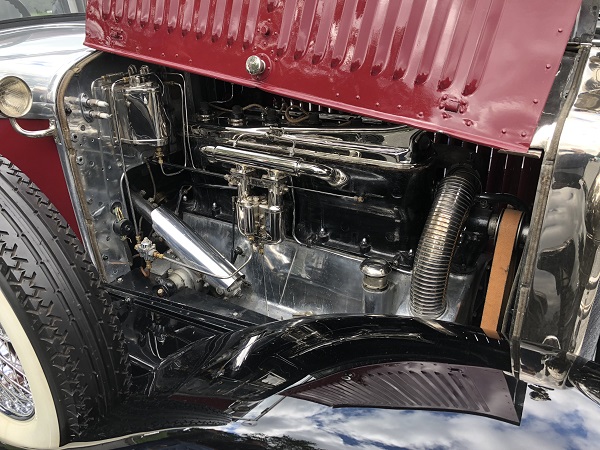
The impressive mascot of the goddess Minerva
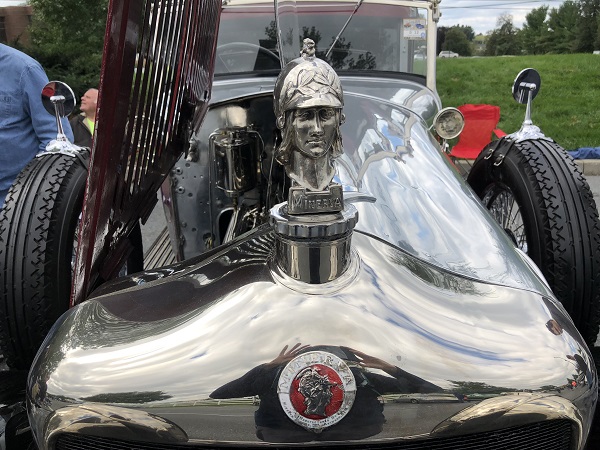
1912 Lozier
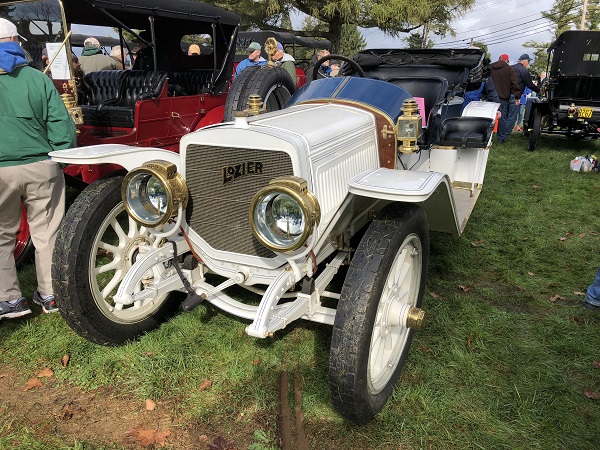
On the final Saturday of the Hershey Fall Meet the best cars gather in the aptly-named ‘Show Field’ for concours judging. If the main fields contained parts and complete cars in all states of repair, and the Car Corral showed off some fine examples for sale, in the Show Field the finest were on display. First to attract our attention was this 1912 Lozier. The Lozier Motor Company produced luxury automobiles from 1900 to 1915. The company sent its designers to scour Europe to find examples of the highest quality, and set out to create a car that was the best in America regardless of cost. In 1910, when a Cadillac cost $1,600 and a Packard $3,200, the Lozier range was priced between $4,600 and $7,750.
1931 Jordan G-90
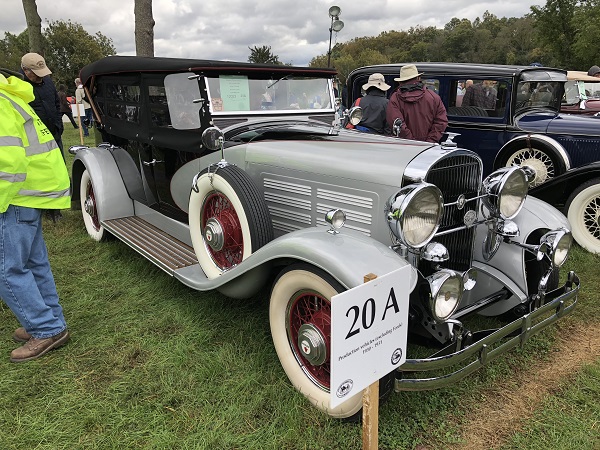
The Jordan company is most famous for its advertisements. These are credited with changing advertising (not just motor car advertising), for ever, by focusing on ‘lifestyle’ – the characteristics of the stylish people that would buy their products. It is said that Jordan advertisements hang in the offices of the top Madison Avenue Agencies to this day, including the very first from 1923, entitled “Somewhere West of Laramie.”
The Jordan was an assembled car with the look of a custom machine, using the highest quality standard components in the industry: Continental engine, Bosch ignition, Stromberg carburettors, Fedders radiator, Bijur electrics, Gemmer steering. This Jordan G-90 is from the last year of production in 1931. As with many companies at that time, it succumbed to the Depression, after making a remarkable 65,000 cars.
1939 Graham Sharknose
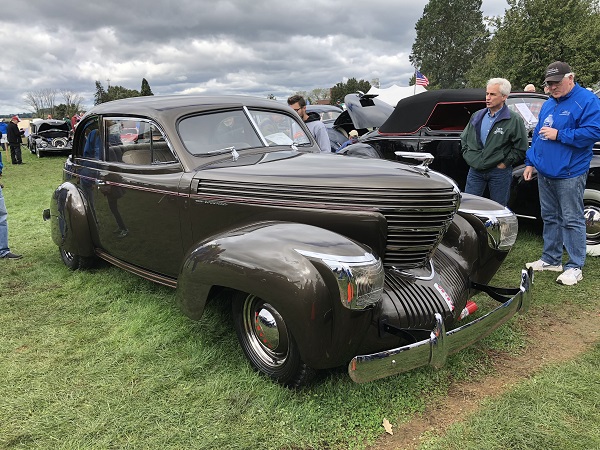
Another car that made people stop and stare is this Graham. The original name given by the Graham company to this unique and ultra-modern design was “”Spirit of Motion,” but the nickname “Sharknose” was given to it by enthusiasts and that’s what has stuck.
The forward-leaning front end was created by the unsung designer Amos Northup The style is inspired by the late 1930s ‘Streamline Moderne’ with multiple layers of horizontal bars. The engine is a Continental L-head straight-six displacing 218 cubic inches and producing 90 bhp. A supercharged option increased this to 116 bhp. The Graham engineers designed exclusive intake and exhaust manifolds for the engine, increasing efficiency and power output.
Just over 8,000 Sharknoses were built during a three-year production run from 1938 to 1940.
That’s the end of our fifth and final report from our American Journey. We hope you enjoyed it. Our next big report will be from Rétromobile 2019 in Paris – including a tiny little truck from Berliet. Watch this space…







Leave a Comment